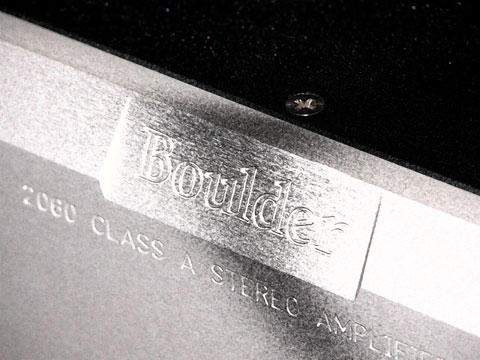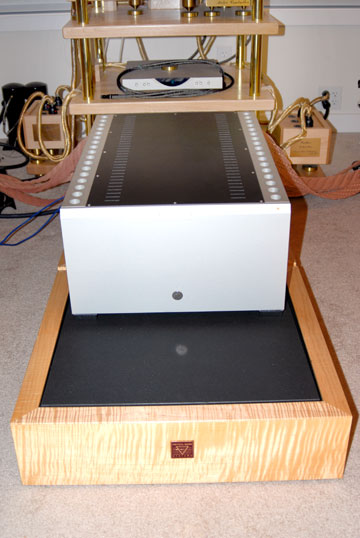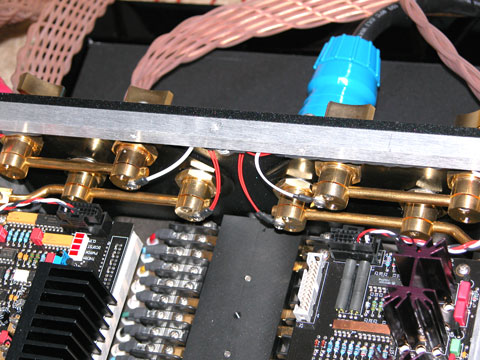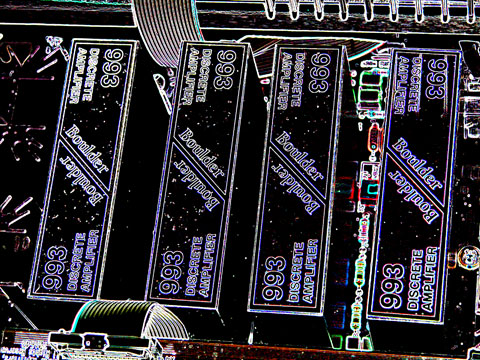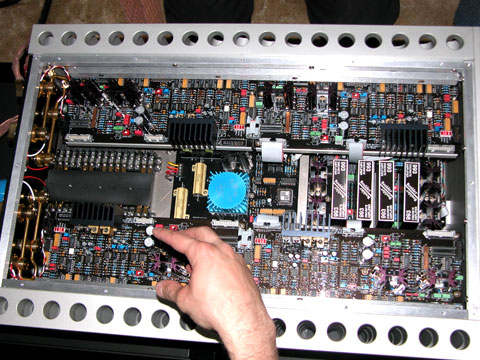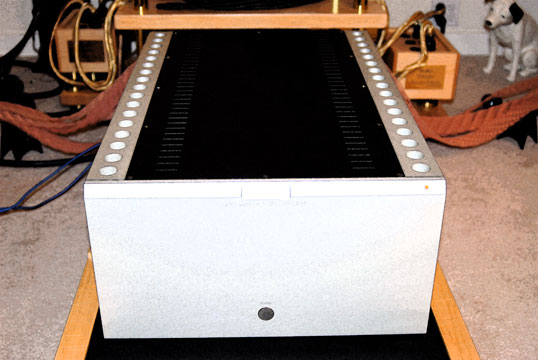|
You are reading the older HTML site
Positive Feedback
ISSUE
27
Impressions - A Sidebar: The Boulder 2060
amplifier …is it "the best I've ever heard"?
[Photographs by Dr. S. and David W. Robinson; all image processing by Robinson]
Sidebar time! Many thanks to PFO's Dr. Sardonicus for his commentary on the Boulder 2000 series system elsewhere in this issue (see www.positive-feedback.com/Issue27/boulder.htm). This was a project that took a lot of logistical planning and support; Dr. S. took the lead in making this happen, working closely with the estimable Rich Maez of Boulder. Getting the Boulder 2010 preamplifier, 2020 DAC and 2060 stereo amplifier in for evaluation provided us with an opportunity to extend our audio education with a very important American product line—we took full advantage of it.
Who is this darkly mysterious, but brilliant character, with the Boulder remote in hand?! My first impressions over at Dr. S.'s listening room were favorable enough for me to decide that a follow-up listening session in my own room with at least the Boulder 2060 stereo amplifier was in order. This was no small project; the 2060 amp tips the balance beam at some 240 pounds, making it the heaviest single amplifier that I've ever dealt with. (It took the laurels from the previous heavyweight champion, the BAT VK-6200.) The 2010 and 2020 with their associated power supplies are no lightweights either. This meant that we had to truck over some very heavy gear from Sardonicusville to PFO River City. With the help of Jennifer and Michael Crock, this was accomplished during a single, very busy afternoon.
The Boulder 2060 in place in my listening room; the only change from this setup was to bring the 2060 forward a few inches on the pair of CMS platforms, to allow for better load balancing. I only had a few weeks for this "second look", which was just enough time for me to assess the 2060 amplifier. For this project and its restricted timeline, I used the EMM Labs CDSD Signature Edition and the EMM Labs DCC2 Signature Edition as the front end/preamplifier. I took the balanced output from the DCC2 and ran it to the Boulder 2060 using EMM Labs Isopath™ balanced cables on Dedicated Audio cable towers. The 2060 itself was placed on a pair of Critical Mass Systems Grandmaster Black amplifier isolation stands, just like it had been in Dr. S.'s room. The CMS stands are truly superb (review coming shortly), but they do have definite weight limitations. The 240 pound Boulder 2060 pressed the pair of CMS stands to the very limit of what the pair could handle, since each is rated out to 130 pounds. I would recommend that anyone looking to duplicate this setup should contact Joe Lavrencik at CMS for a custom solution for a much heavier load (see http://criticalmasssystems.com).
The output of the 2060 was then fed through a bi-wire pair of JENA Labs speaker cables (Pathfinders to the mid/tweet section; Symphonies to the bass) to the very fine Von Schweikert VR-5 SE's (approximately 94dB/Watt/meter) now in for review. No line conditioners were used during my sessions; the 2060 was plugged directly into one of my two fully dedicated 20 amp amplifier circuits in the back end of my listening room. Power cable tweakers take note: the 2060 does not have a standard IEC. You'll be using the special heavy duty cable that comes with it.
The interior and backplane of the Boulder 2060, showing the beefy construction used. The 2060 is massively constructed: the fully (and truly) balanced input circuit is shaped around a pair of the Boulder 993 Gain Stage Modules. These in turn feed an output of 80 (!) output transistors and 48 capacitors, keep everything nicely linear, and well within comfortable operating parameters for all components. Operation is pure Class A, though with dynamic load-sensing, thus allowing a flexible response to a variety of signals and requirements. This means that the 2060 doesn't have to be slurping maximum power at all moments to be ready to provide a Class A envelope for playback—a very good thing.
The Boulder 993 modules, in edge-glowing glory!
A view of the interior of the 2060 (unplugged!), with a hand for scale reference. I have to say that every aspect of the 2060's design impressed me deeply. Externally, the chassis design and finish were exemplary, truly faultless in my estimation. The look is clean and massive. The heat sinks are very large, and provide very large thermal dispersion. One item to note in the photograph above is the construction of the finger holes in the heat sinks. These are fully polished on all edges to allow their use as hoists for the 2060. Either two (minimum!), three or four persons will find them to be quite comfortable for moving/placing the 2060. This means that separate handles are not required, contributing to the elegant lines of the Boulder design. I could wish that more designers of heavy amplifiers paid attention to this important detail. The top cover and the heatsinks of the 2060 are heavily dampened straight from the factory. I don't know that I can remember seeing this in any other amplifier that I've seen. No ringing, no excess vibration allowed—other amplifier designers, please take note! There's no excuse for expensive gear to have chassis that ring like a bell, buzz, or rattle. The no-holds-barred design of the 2060 even includes the feet of the unit. They incorporate layered vibration dampening in their construction, instead of the all-too-common screw-on feet found in too many designs. Clearly Boulder intends that the 2060 require no tweakery at all, since so many of the most common offenders were taken into account in its design and execution. All of this, and delivering an awesome 600-wpc into 8, 4, or 2 Ohms, with a right proper doubling of peak power into declining impedance: 600-wpc into 8 Ohms, 1200-wpc into 4 Ohms, and a smashing 2400-wpc into 2 Ohms. Caramba. This is the real deal for musical presence with any speaker I know of. Reflections on the sound of the 2060 And the sound? Well, first of all, the 2060 and the EMM Labs DCC2 preamp loved each other in balanced mode. Operation was dead quiet ...no hum, no 60Hz, no nothing. Only the Linn reference gear has achieved the level of dead quiet under gain that I heard with this combination. Using a variety of reference SACDs, I'd have to say that my reaction was a continuous, bemused "WOW!" Long-time readers know full well that my audio voyage has been in pursuit of mic feeds and master tapes ...the original signal as received from the microphones, or from the master recording…no more, no less. My entire equipment stack has been assembled over time with the sole purpose of achieving that end. The EMM Labs Signature Edition front end gives me what I'm looking for on the digital/preamp front for both SACD and CD playback; the Walker Audio Proscenium turntable system with either the Linn Kontrol preamp (solid-state) or the deHavilland Mercury II (tube) gives me the same uncompromising result on the LP side of the equation. The two key sources are good. Power conditioning and cables are in good shape, and I have several alternatives on speakers that I am investigating.
The mighty 2060 in place; behind it, my Walker Audio Proscenium gazes on from Mount Olympus, while Nipper does the same from the corner.... But the great missing piece of the puzzle in my listening room has been amplification. I have sought maximum bandwidth ("DC to light" is a very good thing; note that the 2060 has a -3dB down point at 0.015Hz (!!) and 200kHz (!!), which is a very reasonable approximation of said DC to warp drive), substantial power under load, quickness of response to changing signal, and reasonable matching of impedance at both ends. And I have listened to a number of reference-grade components over the years in pursuit of an all-encompassing design. Heretofore, Jud Barber's Joule Electra Rite of Passage OTLs (220-wpc) and the Wavac HE-833 v1.3 (150-wpc) ...particularly the latter, I'd have to say ...have been at the top of the heap for me. In fact, had I been able to afford the v1.3, I would have purchased them, and they're still the top tube amps that I've heard to date. I also liked Scott Frankland's Wavestream V-8 immensely when they were in production, and his prototype Wavestream 100-wpc model was really choice when I heard it back in 2001. [Flash update, sports fans!: Brian Hartsell of the Analog Room ASSURES me that Wavestream V-8's are available. Great news! I will be following up on the Wavestream....] But ...all of this was before I heard the Boulder 2060. Since then, I have to confess that I've been thinking about my experience with the 2060. A lot. The quality of the experience, and its congruence with my goal of "mic feeds and master tapes," forces me to ask a question that I usually don't have to ask very often: Is the Boulder 2060 stereo amplifier "the best I've heard"? The problem is that there really can only be one "the best" in any pantheon of fine audio components, despite the fact that some reviewers seem to have a "the best—of the month" system in play. The overuse or hyping of any term or phrase leads to a loss of significance for the words involved; they are leached of meaning, and become mere fodder for more marketing dronery. To avoid this sort of thing means that I have to think back over many years of audio experience and weigh the merits of the 2060. These merits are considerable. First of all, there were no demerits of the stereotypical solid state that I heard. No harshness, no glare, no brittleness, no grain, no Technicolor "in your face" dynamics, no lack of roundness, no vague imaging or foreshortening of soundstaging. No noise. No bad behavior. No hassles (other than immense weight, and the logistics thereof). No pooping out on any recording, no matter how dynamic. Beyond these "absence of vice" virtues, the 2060 manifested the most completely neutral presentation that I have ever heard. By comparison, every other amplifier that I've heard must slide aside from the midpoint of my tonal continuum; the 2060 sets the new standard for "spot on" invisibility. It's as if it comes with its own cloaking device; the 2060 is simply not there. Furthermore, the ease that this sort of power output provides made the best of my DSD/SACD records simply fly and soar out of the Von Schweikert VR-5 SEs. There was no doubt that the BIG DOG had arrived; the VR-5s stood up at attention and instantly saluted the signal! Want to hear what your speakers can do? The 2060 can show you. (And if you want even MORE POWER, a pair of the 2050 monoblocks, at 1000 Watts per channel will take care of that nicely. Of course, make sure that your electrician prepares the local circuits for the load ...and that your local grid is up to snuff, eh?) In sum: gain without pain; dynamics without effort; transparency without veiling. Transparency. Readers of my work know how much this audio virtue has been growing in my mind. I believe that it may be the foundation of all other audio virtues, the summum bonum that we strive for in the audio arts. The Boulder 2060 nearly induced vertigo as I listened to it; in tandem with the EMM Labs DCC2 Signature Edition preamplifier and CDSD transport, there was simply an effortless, colorless ease, an authority of presence that is that most rare thing in audio. I found myself having to rearrange my personal continuum of amplifiers as I listened; the Boulder 2060 is now firmly planted right at the center of tonal scale, and right at the top of the transparency, ease, dynamics and authority scale. This is a amazing thing for me; only once in a while does a design force this kind of major shift in my rankings. Dr. S. and I will have to discourse on this one. He was extremely impressed by the 2060, and respects it, but still gives the nod of the heart to the BAT VK-600 SE as having a warmer touch for the music. Does this mean that the 2060 is an "Ice Queen", with a neutrality that freezes the heart, or leaves one uninvolved? Not at all! Not in my opinion ...but perhaps Dr. Sardonicus and I should engage this one in our long-awaited Dialogues! Dr. S.: come forth! Accuracy! Musicality! Head! Heart! Do we have some "audio responses" that represent preferred deviations from what we would feel in a recording studio, listening to a mic feed? (Accuracy? Musicality? Can't they be merged?!) Shall we joust?! Is it the best I've heard? Carefully now, David ...easy now! What do I think? Am I sure? You know, I think I am sure. I think that the Boulder 2060 stereo amplifier is the best amplifier that I can remember hearing. During the time that it was here, I heard SIGNAL. I didn't hear NON-SIGNAL.
I find the highest joy in the audio thing itself. Give me truth; I'll deal with beauty. In my opinion, the ultimate height of the audio arts is to make the two become one. And in our best recordings, played back through our best systems, they are. Bring the audio event borne by the original signal/recording (NOT "live music," that wrong-headed audio chimera!) into my listening room, and do not get in the way. This is what I'm looking for. The Boulder 2060 gave it to me. (And at half the MSRP of the Wavac HE-833 v1.3's, no less.) I'm still coming to grips with the experience....
Boulder Amplifiers Inc.
|

